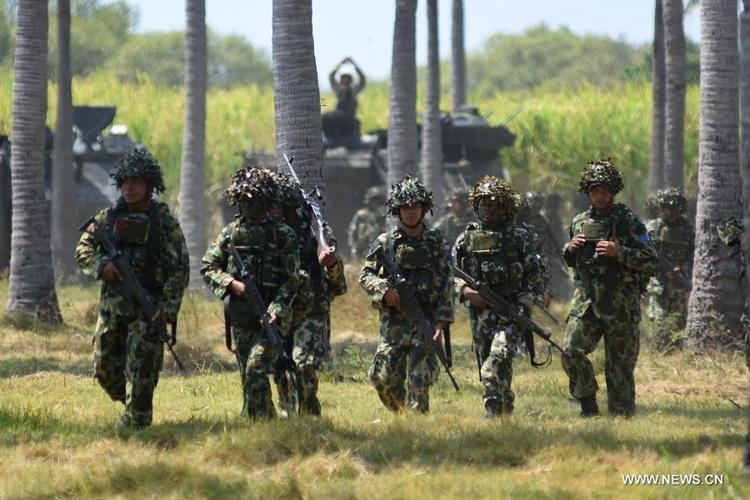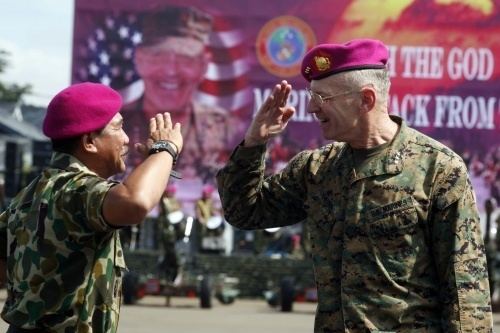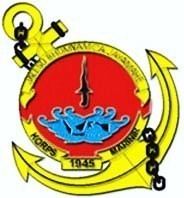Active 15 November 1945 Allegiance President of Indonesia Color Purple Branch Indonesian Navy | Country Indonesia Type Naval Infantry Founded 15 November 1945 | |
 | ||
Size 1 Marine Divisions, 1 Independent Brigade Part of Indonesian National Armed Forces Tentara Nasional Indonesia (TNI) Motto Jalesu Bhumyamca Jayamahe (Sanskrit): On the Water and Land, We are Glorious Headquarters Central Jakarta, Jakarta, Indonesia Similar Indonesian Navy, Indonesian Army, Indonesian Air Force, Paskhas, Paspampres | ||
Indonesian marine corps 2015
The Indonesian Marine Corps (Indonesian: Korps Marinir) officially known as KORMAR or simply "Marinir", Tentara Nasional Indonesia – Angkatan Laut, ("KORMAR", TNI-AL); officially translated as: Marine Corps, Indonesian Navy is the currently integral part of the Indonesian Navy (TNI-AL) and sized at the military corps level unit as the Naval Infantry and main amphibious warfare force of Indonesia. There are future plans to expand the Indonesian Marine Corps to become an independent, uniformed force. It is commanded by a two star marine general (nothing that it does not use the Admiral title). It has two divisions, which are:
Contents


The two marine divisions (PASMAR I and II) are each led by a one star admiral (Brigadier General/Commodore).
History
The Corps Mariniers (CM), the predecessor of the marine corps was established on 15 November 1945 at Navy Base IV of ALRI (Angkatan Laut Republik Indonesia) in Tegal. The marine corps was initially formed as a training for Indonesian seamen who joined the Navy, in order to fight on the ground when there is an emergency. Marines eventually were forced to join guerrilla warfare on land due to lack of sea defense equipments. In other places, the Corps were widely known as the "ALRI Gunung" (Navy of the Mountains) because it is more frequent fighting in the jungle and the foot of the mountain, rather than at sea. But they are not included yet in the marine corps for this latest new corps at that time only exist in Navy Base IV in Tegal, not in other naval bases. The marine corps from Tegal sent troops to Semarang front of the Revolution 25 times to aid the People's Security Army (TKR) whose personnel were losing to the Dutch. In the midst of the revolutionary period, precisely on 17 March 1948 there have been a reorganization and rationalization of the marine corps. At that time, because the marine corps had a lot of combat experience on the ground, the government , through the Ministry of Defense, decided to separate it from the Navy.
Corps Mariniers was then merged into the Diponegoro Division of the army by the name of Samudera Regiment and was divided into five battalions. Marine soldiers who wishto remain in the navy must submit a written request to the Minister of Defence and Commander in Chief of the Armed Forces. On October 9, 1948, the Minister of Defense ratified Decree No. A / 565/1948, declaring the establishment of the marine corps. Nevertheless, the acceptance of new personnel only started after the Round Table Conference (RTC) in 1949. Selection reception was held at the main naval base in Surabaya. Approximately 1,200 recruits were selected to join the new naval amphibious forces. After being examined, it turns out 95 percent of the 1,200 people who received it are personnel are formerly part of the Corps Mariniers established in Tegal. Of all the personnel of the Korps Komando Operasi Angkatan Laut (KKO AL) listed in its 1950 personnel roster, 90 percent of the personnel were veterans of the Corps Mariniers of 1945. Therefore, the existence of marine Corps formed in 15 November 1945 as mentioned in the previous paragraphs, jis ustified as the forerunner of the Navy Marine Corps today.
The marine crops has been active in various military operations in Indonesia. One of the largest amphibious military operations would have been Operation Jayawijaya in which thousands of marines were planned to land on Biak in 1963 as a part of the Trikora Campaign to take West Irian from Dutch control. The operation was aborted as a consequence deals preceding the New York Agreement.
At the height of the Indonesia-Malaysia Confrontation, Harun Hj Mohd Said and Usman Ali (hereinafter known as Usman Harun), two members of the Marine Corps were dispatched to Singapore using rubber boats. Their main task is to infiltrate and sabotage the interests of Malaysia and Singapore. In practice, these operations are only able to blow up the MacDonald House and cause civilian and non-military casualties. In that incident, 20 fruit shops around the hotel was heavily damaged, 24 pieces sedan vehicles were destroyed, 30 people died, 35 people suffered serious injuries and mild. This incident is known as the MacDonald House bombing. Usman and Harun were unable to escape from Singapore and was eventually arrested and sentenced to death by the Singapore government.
In 1999 a plan was proposed to expand the Kormar from its strength of 13,000 troops. Based on this plan, every Kormar's base would have three combat brigades: the Infantry, Cavalry, and Artillery and would be supported by one Combat Support Regiment and one Administration Support Regiment. The expansion will create three Kormar bases: Surabaya for Eastern area command, Jakarta for Central area command, and Rate Island in Lampung for Western area command. Now the Indonesian Marine Corps has an estimated 29,000 troops in two Marine Forces (PASMARs) and one independent infantry marine regiment, when combined equal to one over-strength infantry division, which includes its own sizeable mechanised amphibious and artillery units.
Following a reorganisation introduced in March 2001, the corps consisted of the 1st Marine Corps Group (1,3,5 Battalions) at Surabaya, and the Independent Marine Corps Brigade (2,4,6, Battalions) at Jakarta.(JDW 11 April 2001). The 8th Bn was formed in January 2004 and the 9th Bn was due to be formed in April 2004. They were planned to be part of a new group that would include the 7th Bn and support elements. (JDW 18 February 2004, p. 18) The same Jane's Defence Weekly story (Robert Karniol, 'Indonesia Reinforces Marines') said the Marine Corps leadership is reported to have ambitions for the service to expand to at least two full divisions. However it was reported that the army was opposed, 'perhaps reflecting its leadership's concern over influence.'
Organisation
2 Marine Forces plus one independent brigade (forming as part of Ten Year Defence Plan 2004–13)
Plus other independent units:
